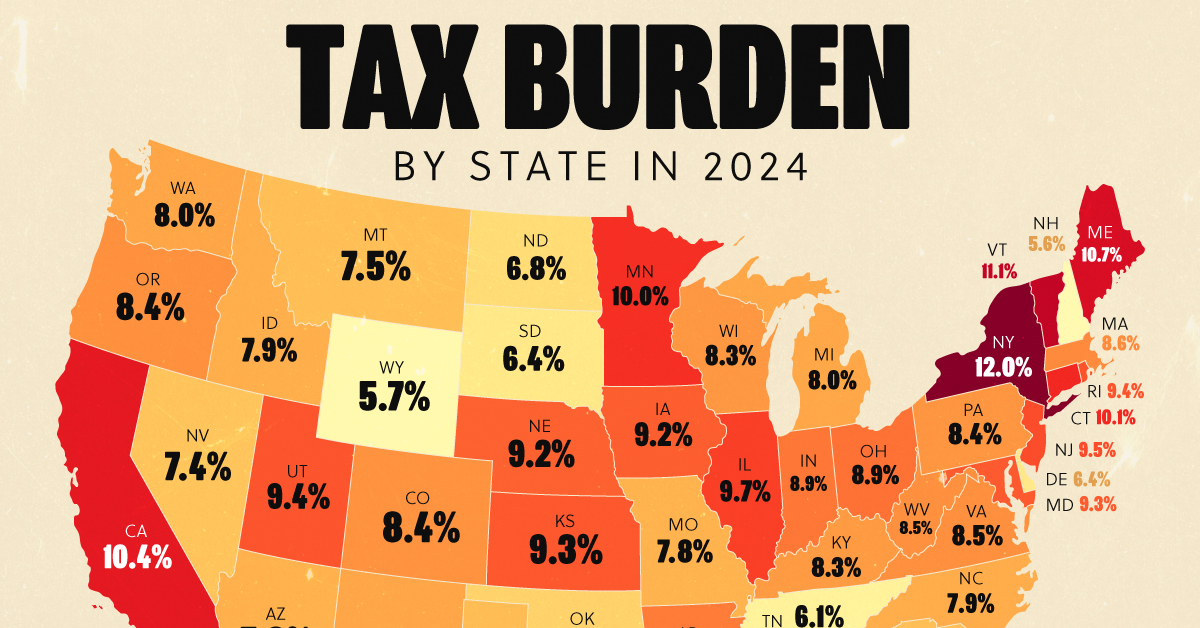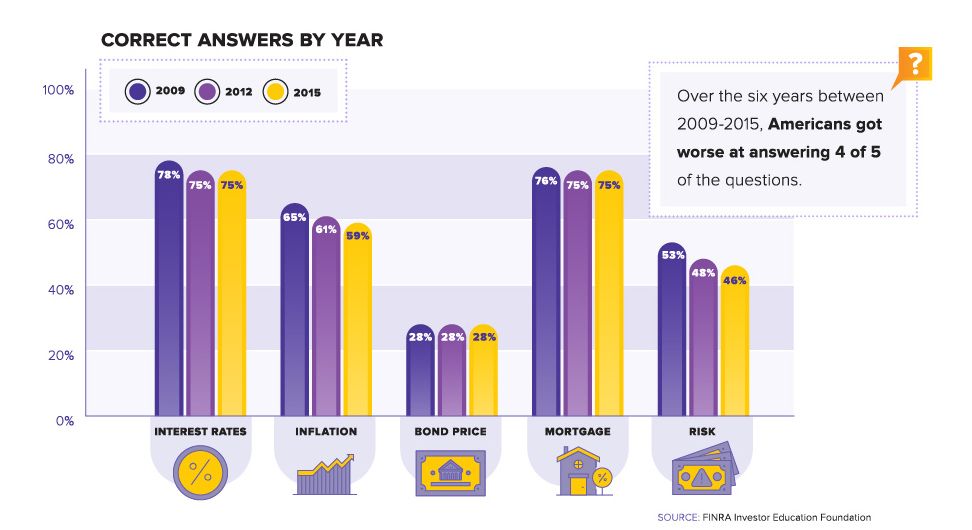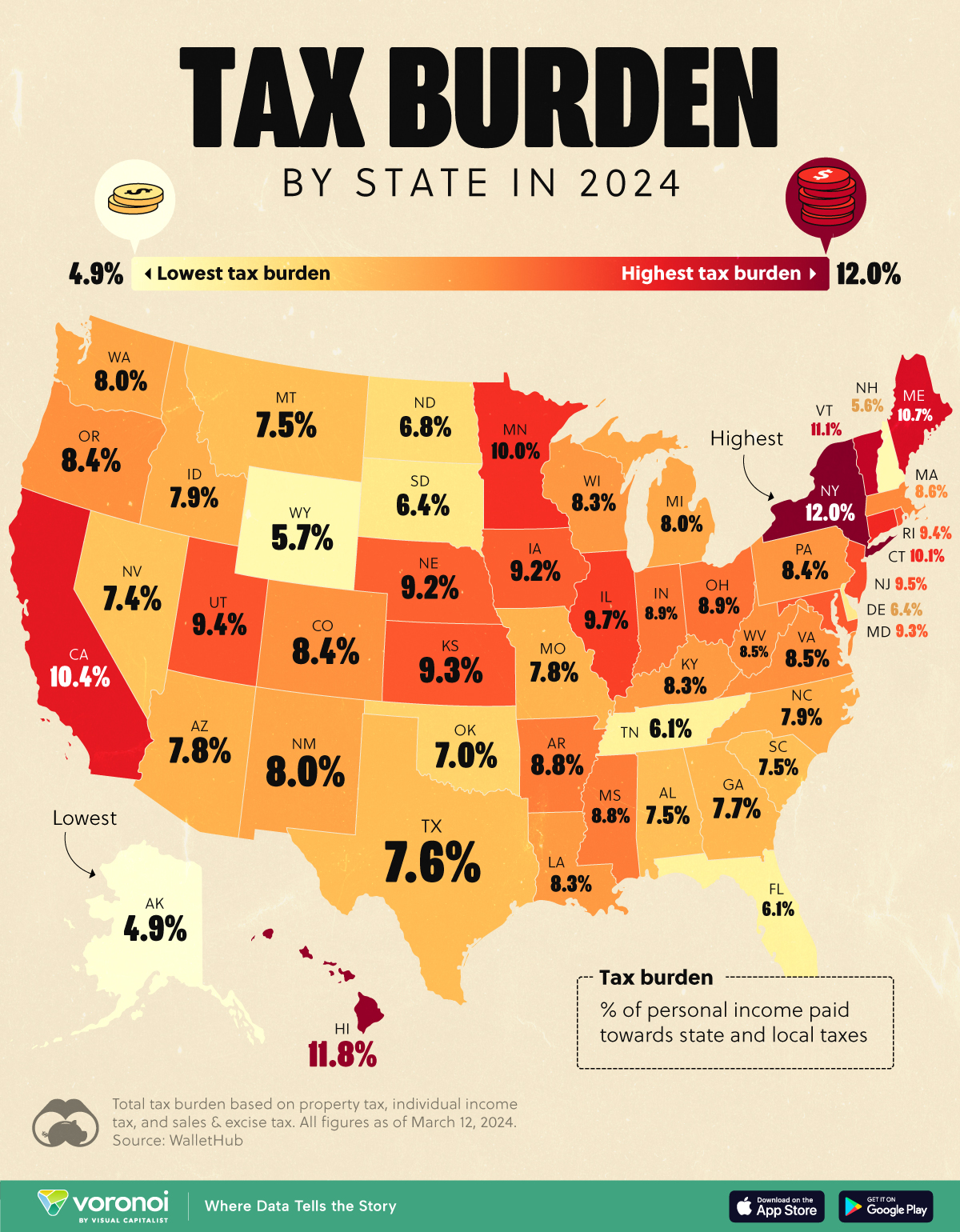Personal Finance
America’s Growing Financial Literacy Problem

America’s Growing Financial Literacy Problem
Making major personal finance decisions can be daunting for anyone.
Whether the decision is related to paying back student debt or how to invest for the first time, the outcomes of these decisions have a long-term impact on the quality of our lives. Smart decisions can lead to achieving financial independence, while bad decisions can lead to years of being stuck in the “hole”.
Even though it’s clear that financial literacy is important, there’s a big problem: it’s actually been dropping for years in the United States.
Diagnosing the Problem
Today’s infographic was done in conjunction with Next Gen Personal Finance, a non-profit that provides a free online curriculum of personal finance courses geared to students.
The graphic paints a troubling picture of the current financial literacy situation in the country, while demonstrating why personal finance is a crucial area of study for our youth.
Here are some of the indicators that show literacy is dropping:
- The U.S. ranks 14th globally in terms of financial literacy
- With a 57% literacy, the U.S. beats Botswana (52%) but gets edged out by countries like Germany (66%) or Canada (68%)
- Only 16.4% of U.S. students are required to take a personal finance class in schools
- 76% of millennials lack basic financial knowledge
- Between 2009-2015, Americans got worse at answering five key personal finance questions posed by FINRA – a major U.S. financial regulator
And worse, this lack of knowledge is translating into anxiety and even fear.
- Four of five adults say they were never given the opportunity to learn about personal finance
- 70% of millennials are stressed and anxious about saving for retirement
- 22% of millennials feel overwhelmed about their finances
- 13% of millennials feel scared
Meanwhile, student debt is soaring to new highs – how do we put our students in a better spot to succeed?
The Road Ahead
As financial products continue to increase in complexity, the road ahead is not an easy one.
However, there is still a great case for optimism: 60% of Americans say they know someday they will need to be more financially secure – they just don’t know how to get there. This number increases to 70% for those between the ages of 18-39 years old.
This means there is actually a great thirst for financial education out there – the question is just how to best deliver that information in a compelling way.
Another good sign? The youngest generation, Gen Z, is already starting to think about money differently:
Gen Z saw millennials struggle with wage stagnation and huge college debt, so they took note and are making a conscious effort to approach money and debt differently.
– Jason Dorsey, Center for Generational Kinetics
Real World Benefits
Increased financial literacy translates into real world benefits for individuals, and to the economy as a whole.
People with strong financial skills are better at job planning and saving for retirement. Meanwhile, financial savvy investors are more likely to diversify risk, and students that take a personal finance course see up to a 5.2% increase in credit scores within two years.
Lastly, consumers that understand compound interest:
- Spend less on transaction fees
- Accrue less debt
- Incur lower interest rates on loans
- Save more money
And this is just scratching the surface of what could be possible.
Making the right financial decisions can help people meet their own personal goals, live a life of abundance, get out of debt, and become financially independent.
This infographic was originally published on the Wealth 101: A Crash Course in Personal Finance minisite, a collaboration between NGPF and Visual Capitalist
Personal Finance
Visualizing the Tax Burden of Every U.S. State
Tax burden measures the percent of an individual’s income that is paid towards taxes. See where it’s the highest by state in this graphic.

Visualizing the Tax Burden of Every U.S. State
This was originally posted on our Voronoi app. Download the app for free on iOS or Android and discover incredible data-driven charts from a variety of trusted sources.
This map graphic visualizes the total tax burden in each U.S. state as of March 2024, based on figures compiled by WalletHub.
It’s important to understand that under this methodology, the tax burden measures the percent of an average person’s income that is paid towards state and local taxes. It considers property taxes, income taxes, and sales & excise tax.
Data and Methodology
The figures we used to create this graphic are listed in the table below.
| State | Total Tax Burden |
|---|---|
| New York | 12.0% |
| Hawaii | 11.8% |
| Vermont | 11.1% |
| Maine | 10.7% |
| California | 10.4% |
| Connecticut | 10.1% |
| Minnesota | 10.0% |
| Illinois | 9.7% |
| New Jersey | 9.5% |
| Rhode Island | 9.4% |
| Utah | 9.4% |
| Kansas | 9.3% |
| Maryland | 9.3% |
| Iowa | 9.2% |
| Nebraska | 9.2% |
| Ohio | 8.9% |
| Indiana | 8.9% |
| Arkansas | 8.8% |
| Mississippi | 8.8% |
| Massachusetts | 8.6% |
| Virginia | 8.5% |
| West Virginia | 8.5% |
| Oregon | 8.4% |
| Colorado | 8.4% |
| Pennsylvania | 8.4% |
| Wisconsin | 8.3% |
| Louisiana | 8.3% |
| Kentucky | 8.3% |
| Washington | 8.0% |
| New Mexico | 8.0% |
| Michigan | 8.0% |
| North Carolina | 7.9% |
| Idaho | 7.9% |
| Arizona | 7.8% |
| Missouri | 7.8% |
| Georgia | 7.7% |
| Texas | 7.6% |
| Alabama | 7.5% |
| Montana | 7.5% |
| South Carolina | 7.5% |
| Nevada | 7.4% |
| Oklahoma | 7.0% |
| North Dakota | 6.8% |
| South Dakota | 6.4% |
| Delaware | 6.4% |
| Tennessee | 6.1% |
| Florida | 6.1% |
| Wyoming | 5.7% |
| New Hampshire | 5.6% |
| Alaska | 4.9% |
From this data we can see that New York has the highest total tax burden. Residents in this state will pay, on average, 12% of their income to state and local governments.
Breaking this down into its three components, the average New Yorker pays 4.6% of their income on income taxes, 4.4% on property taxes, and 3% in sales & excise taxes.
At the other end of the spectrum, Alaska has the lowest tax burden of any state, equaling 4.9% of income. This is partly due to the fact that Alaskans do not pay state income tax.
Hate Paying Taxes?
In addition to Alaska, there are several other U.S. states that don’t charge income taxes. These are: Florida, Nevada, South Dakota, Tennessee, Texas, Washington, and Wyoming.
It’s also worth noting that New Hampshire does not have a regular income tax, but does charge a flat 4% on interest and dividend income according to the Tax Foundation.
Learn More About Taxation From Visual Capitalist
If you enjoyed this post, be sure to check out this graphic which ranks the countries with the lowest corporate tax rates, from 1980 to today.
-

 United States1 week ago
United States1 week agoMapped: Countries Where Recreational Cannabis is Legal
-

 Healthcare2 weeks ago
Healthcare2 weeks agoLife Expectancy by Region (1950-2050F)
-

 Markets2 weeks ago
Markets2 weeks agoThe Growth of a $1,000 Equity Investment, by Stock Market
-

 Markets2 weeks ago
Markets2 weeks agoMapped: Europe’s GDP Per Capita, by Country
-

 Money2 weeks ago
Money2 weeks agoCharted: What Frustrates Americans About the Tax System
-

 Technology2 weeks ago
Technology2 weeks agoCountries With the Highest Rates of Crypto Ownership
-

 Mining2 weeks ago
Mining2 weeks agoWhere the World’s Aluminum is Smelted, by Country
-

 Personal Finance2 weeks ago
Personal Finance2 weeks agoVisualizing the Tax Burden of Every U.S. State













